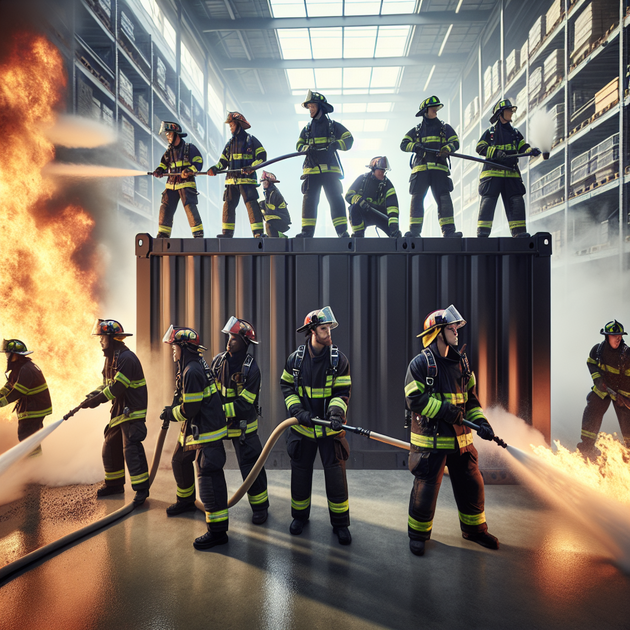Ever wonder what really happens after a large lithium battery catches fire? While these powerful batteries help run everything from cars to backup power systems, they come with their own set of risks—especially when things go wrong. One spark can lead to a dramatic blaze that’s tough to stop. That’s why knowing the right safety measure after a lithium battery fire is so important.
Why Lithium Battery Fires Are So Dangerous
Lithium batteries are everywhere these days—our phones, laptops, electric vehicles—even our power grids rely on them. But when they’re damaged or overheated, they can go from harmless to hazardous in seconds. What makes lithium battery fires so tricky is something called “thermal runaway.” Once one cell overheats and ignites, it can quickly set off neighboring cells like dominos.
Unlike ordinary fires, you can’t just throw water on a lithium battery blaze. In fact, water can make things worse by reacting with the chemicals inside the battery. This unique risk means that specific protocols must be followed as soon as the flames start.
The Main Safety Measure After a Large Lithium Battery Fire
So what do experts actually do once the smoke starts rising? The number one safety measure after a large lithium battery fire is containment—isolating the burning material and making sure it doesn’t spread. Here’s how professionals usually handle it:
- Evacuate the Area: First things first—get people out of harm’s way as quickly as possible.
- Call Emergency Services: Fires involving large batteries need specialized firefighting teams familiar with electrical fires.
- Use Class D Fire Extinguishers: Only certain extinguishers work for these fires—standard foam or water won’t cut it.
- Cool Surrounding Batteries: Sometimes firefighters use water or special mists around—not on—the burning area to prevent other cells from catching.
- Monitor for Re-Ignition: Lithium batteries can flare up again even after appearing “out.” Teams watch closely for hours or days.
- Ventilate and Remove Smoke: Toxic fumes are common; ventilating safely is crucial.
The goal is to contain the problem before it escalates—not just put out visible flames but keep hidden dangers under control.
The Science Behind Containment
Why all this fuss about isolation? When one cell in a big lithium battery fails—including those giant packs used in grid storage or electric vehicles—it can trigger neighboring cells through heat alone. If left unchecked, that chain reaction spreads fast.
Containment usually means firefighters will try to cool down unburned parts of the pack (sometimes with sprinklers or cold mists) while using dry powder extinguishers directly on flames. They’ll also create barriers—physical shields or sandbags—to stop burning material from reaching other flammable stuff nearby.
Sometimes entire rooms or containers get sealed off until temperatures drop back to safe levels—a process that could take many hours.
A Real-Life Example
A few years ago at an energy storage facility in Arizona, a large lithium-ion battery went into thermal runaway and caught fire unexpectedly. Responders evacuated everyone immediately and kept clear of the building due to explosion risks and toxic fumes.
Instead of rushing in with hoses blazing, crews set up remote temperature sensors and waited until most of the energy had burned off safely inside the enclosure. It wasn’t about fighting flames directly—it was about preventing further damage by containing everything inside one controlled space.
This method worked—the incident didn’t spread beyond its room, and nobody was hurt.
What Can You Do To Stay Safe?
Most of us won’t run into massive industrial-grade batteries at home—but smaller versions live under our roofs every day. Here are some tips you can use:
- Store Devices Properly: Keep gadgets away from extreme heat or direct sunlight.
- Avoid Overcharging: Don’t leave devices plugged in unnecessarily overnight.
- If Something Smells Hot: Unplug it! If safe to do so, move it away from flammable materials.
- No Water: Never use water on electronics fires; get help if you see smoke or sparking.
Staying calm and acting quickly makes all the difference—whether it’s your phone overheating or an industrial-sized pack going up in smoke.
Wrapping Up: Would You Know What To Do?
Lithium battery fires don’t happen often—but when they do, quick thinking and proper containment make all the difference between disaster and control. Next time you plug in your devices or hear about electric cars catching fire on the news, remember that there’s science (and some brave people) behind every successful response.
Would you feel prepared if faced with a lithium battery emergency? It’s worth thinking about before you need that knowledge most!

Leave a Reply